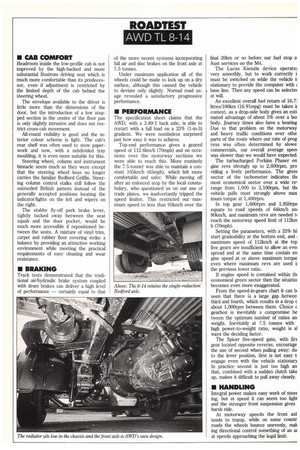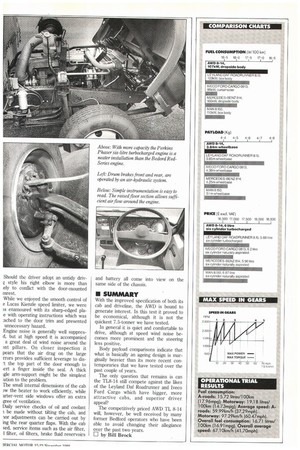• CAB COMFORT
Page 48

Page 49

If you've noticed an error in this article please click here to report it so we can fix it.
Headroom inside the low-profile cab is not improved by the high-backed and more substantial Bostrom driving seat which is much more comfortable than its predecessor, even if adjustment is restricted by the limited depth of the cab behind the steering wheel.
The envelope available to the driver is little more than the dimensions of the door, but the introduction of a low stepped section in the centre of the floor pan is only slightly intrusive and does not restrict cross-cab movement.
All-round visibility is good and the interior colour scheme is light. The cab's rear shelf was often used to stow paperwork and now, with a subdivided tray moulding, it is even more suitable for this.
Steering wheel, column and instrument binnacle seem much as they were except that the steering wheel boss no longer carries the familiar Bedford Griffin, Steering column control stalks still follow the outmoded British pattern instead of the generally accepted positions locating the indicator/lights on the left and wipers on the right.
The stubby fly-off park brake lever, tightly tucked away between the seat squab and the door pocket, would be much more accessible if repositioned between the seats. A mixture of vinyl trim, carpet and rubber floor covering strike a balance by providing an attractive working environment while meeting the practical requirements of easy cleaning and wear resistance.
• BRAKING
Track tests demonstrated that the traditional air/hydraulic brake system coupled with drum brakes can deliver a high level of performance — certainly equal to that of the more recent systems incorporating full air and disc brakes on the front axle at 7.5 tonnes.
Under maximum application all of the wheels could be made to lock up on a dry surface, although this caused the vehicle to deviate only slightly. Normal road usage revealed a satisfactory progressive performance.
• PERFORMANCE
The specification sheet claims that the AWD, with a 3.89:1 back axle, is able to restart with a full load on a 33% (1-in-3) gradient. We were nontheless surprised just how easy it was to achieve.
Top-end performance gives a geared speed of 112.6km/h (70mph) and on occasions over the motorway sections we were able to reach this. More routinely the 7.5-tonner was able to maintain a constant 1051cm/h (65mph), which felt more comfortable and safer. While moving off after an enforced stop by the local constabulary, who questioned us on our use of trade plates, we inadvertantly tripped the speed limiter. This restricted our maximum speed to less than 951crn/h over the final 201an or so before our fuel stop a Aust services on the M4.
The Lucas Kienzle device operate: very smoothly, but to work correctly i must be switched on while the vehicle stationary to provide the computer with t base line. Then any speed can be selectee at wilL An excellent overall fuel return of 16.7: litres/100km (16.91mpg) must be taken it context, as a drop-side body gives an esti mated advantage of about 5% over a bo] body. Journey times also have a bearing Due to that problem on the motorway and heavy traffic conditions over othe parts of the route where our rate of prog ress was often determined by slowe: commercials, our overall average speet was slower than we would have expected.
The turbocharged Perkins Phaser en gine revs strongly up to 2,600rpm, pro viding a lively performance. The greet sector of the tachometer indicates the most economical sector over a wide re, range from 1,000 to 2,100rpm, but the vehicle pulls most strongly above max imum torque at 1,400rpm.
In top gear 1,600rpm and 1,85Orpn equate to road speeds of 641cm/h am 80Iun/h, and maximum revs are needed b reach the motorway speed limit of 1121Ern h (70mph).
Setting the parameters, with a 33% hi start gradeability at the bottom end, and ; maximum speed of 1121cm/h at the top five gears are insufficient to allow an eve] spread and at the same time contain en gine speed at or above maximum torque even where maximum revs are used the previous lower ratio.
If engine speed is contained within tit economical green sector then the situatio; becomes even more exaggerated.
From the speed-in-gears chart it can b; seen that there is a large gap betwee; third and fourth, which results in a drop c about 1,000rpm between them. Choice c gearbox is inevitably a compromise be tween the optimum number of ratios an weight. Inevitably at 7.5 tonnes with high power-to-weight ratio, weight is al ways the deciding factor.
The Spicer five-speed gate, with firs gear located opposite reverse, encourage the use of second when pulling away: du; to the lever position, first is not easy t; engage even with the vehicle stationary In practice second is just too high an; that, combined with a sudden clutch take up, makes it difficult to pull away cleanly.
• HANDLING
Integral power makes easy work of steer ing, but at speed it can seem too light and the stronger front suspension gives harsh tide.
At motorway speeds the front axl tends to tramp, while on some count roads the wheels bounce unevenly, malt ing directional control something of an at at speeds approaching the legal limit. Should the driver adopt an untidy driv.=, style his right elbow is more than ely to conflict with the door-mounted nirest.
While we enjoyed the smooth control of e Lucas Kienzle speed limiter, we were ;s enamoured with its sharp-edged pla e with operating instructions which was ached to the door trim and presented unnecessary hazard.
Engine noise is generally well suppresd, but at high speed it is accompanied a great deal of wind noise around the mt pillars. On closer inspection it pears that the air drag on the large rrors provides sufficient leverage to dis t the top part of the door enough to .ert a finger inside the seal. A thick tgle arm-support might be the simplest tution to the problem.
The small internal dimensions of the cab )i,v the heater to work efficiently, while arter-vent side windows offer an extra gree of ventilation.
Daily service checks of oil and coolant be made without tilting the cab, and -Kir adjustments can be carried out by ing the rear quarter flaps. With the cab sed, service items such as the air filter, 1 filter, oil filters, brake fluid reservoirs
and battery all come into view on the same side of the chassis.
• SUMMARY
With the improved specification of both its cab and driveline, the AWD is bound to generate interest. In this test it proved to be economical, although it is not the quickest 7.5-tonner we have tested.
In general it is quiet and comfortable to drive, although at speed wind noise becomes more prominent and the steering less positive.
Body payload comparisons indicate that what is basically an ageing design is marginally heavier than its more recent contemporaries that we have tested over the past couple of years.
The only question that remains is can the TL8-14 still compete against the likes of the Leyland Daf Roadrunner and Iveco Ford Cargo which have bigger, more attractive cabs, and superior driver appeal?
The competitively priced AWD TL 8-14 will, however, be well received by many former Bedford operators who have been able to avoid changing their allegiance over the past two years. • by Bill Brock


























































